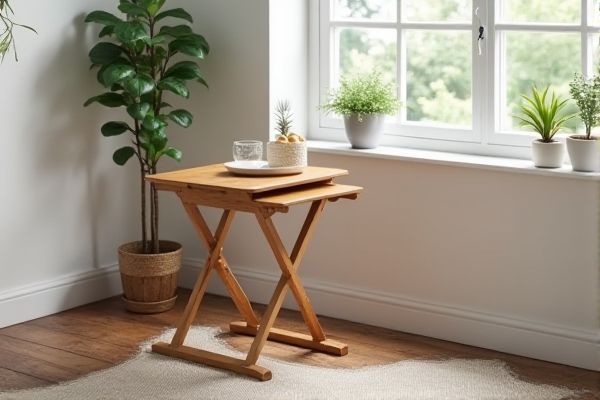
Nesting tables offer compact storage by stacking smaller tables within larger ones, perfect for flexible space management, while folding tables provide portability and ease of setup, ideal for temporary use in various settings. Explore the rest of the article to discover which table best suits Your needs and space constraints.
Table of Comparison
| Feature | Nesting Table | Folding Table |
|---|---|---|
| Design | Multiple tables placed within one another | Single table that can be collapsed or expanded |
| Use Case | Displaying hierarchical or grouped data | Saving space by hiding or showing table content |
| Complexity | Higher due to multiple embedded tables | Lower; one table with toggle functionality |
| Performance | Slower rendering with deep nesting | Faster as content is dynamically shown/hidden |
| Accessibility | May confuse screen readers if improperly structured | Better control with ARIA attributes for folding |
| Maintenance | Complex to update multiple nested tables | Simple to maintain with fewer elements |
| Responsiveness | Challenging with deeply nested layouts | More adaptable due to content toggling |
Introduction to Nesting Tables and Folding Tables
Nesting tables are designed to stack compactly within each other, optimizing space by allowing multiple tables to occupy the footprint of one. Folding tables feature hinged legs or surfaces that collapse flat for easy storage and portability, ideal for temporary setups. Both table types maximize practicality in small spaces, balancing convenience with efficient design.
Design and Structure Comparison
Nesting tables feature a compact, stackable design that allows smaller tables to slide neatly beneath a larger one, optimizing space and offering versatile layout options. Folding tables incorporate hinges that enable the tabletop or legs to collapse flat, prioritizing portability and ease of storage for temporary setups. The structural distinction lies in nesting tables' rigid frames supporting multiple units versus folding tables' flexible joints designed for quick assembly and disassembly.
Space-Saving Capabilities
Nesting tables excel in space-saving capabilities by allowing multiple tables to stack seamlessly within one another, optimizing floor area and providing versatile use in compact environments. Folding tables enhance space efficiency through their collapsible design, enabling easy storage against walls or inside closets when not in use. Both options maximize room utility but nesting tables offer quicker access and aesthetic cohesion, while folding tables prioritize portability and flexible placement.
Material and Durability Differences
Nesting tables are often constructed from solid wood or metal frames with tempered glass tops, providing a sturdy yet elegant design that resists wear and tear over time. Folding tables typically feature lightweight aluminum or plastic materials, making them portable but less durable under heavy or prolonged use. Your choice depends on whether you prioritize the robust longevity of nesting tables or the convenience and flexibility of folding tables.
Portability and Mobility
Nesting tables offer superior portability with their ability to stack compactly, making them easy to move and store in tight spaces. Folding tables provide excellent mobility by collapsing flat, allowing you to transport them conveniently for events or temporary setups. Your choice depends on whether you prioritize space-saving storage or ease of transport in varied locations.
Assembly and Setup Ease
Nesting tables require minimal assembly, often arriving pre-assembled or with simple attachment steps, making setup quick and hassle-free. Folding tables typically include hinges and locking mechanisms that unfold easily without tools, allowing fast deployment and compact storage. Both designs prioritize user-friendly setups, but folding tables offer greater portability due to their collapsible nature.
Versatility in Usage Scenarios
Nesting tables provide exceptional versatility by allowing multiple smaller tables to be stored compactly and used individually or together in living rooms, offices, or cafes. Folding tables excel in portability and quick setup, making them ideal for temporary workspaces, events, or outdoor activities. Both options offer adaptable solutions, with nesting tables suited for space-saving storage and folding tables offering easy transport and instant usability.
Aesthetic Appeal and Style Options
Nesting tables offer a sleek, modern aesthetic with clean lines and space-saving design, making them ideal for contemporary interiors. Folding tables provide versatile style options, ranging from rustic wood finishes to minimalist metal frames, allowing customization to suit various decor themes. Your choice depends on whether you prioritize the compact elegance of nesting tables or the adaptable charm of folding tables for your living space.
Maintenance and Cleaning Requirements
Nesting tables require minimal maintenance with smooth surfaces that are easy to wipe down, while folding tables may need more frequent checks for joint stability and hinge lubrication to prevent wear and tear. Cleaning must address dirt and debris that can accumulate in folding table hinges, whereas nesting tables typically have fewer crevices. Choosing between the two depends on your preference for hassle-free upkeep or compact storage solutions.
Price Range and Value for Money
Nesting tables typically range from $50 to $200, offering excellent value for small spaces due to their compact, stackable design. Folding tables vary widely, from affordable budget options at $30 to more durable models exceeding $150, providing versatility and easy storage. Both types deliver strong value for money, with nesting tables excelling in space efficiency and folding tables offering portability.
 homyna.com
homyna.com